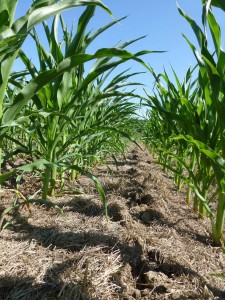In the summer of 2011 I was contacted by Martha Mintz , a contributing editor for No-Till Farmer Magazine (some of my favorite farm reading!) about helping her with an article on how cover crops help provide improved weed suppression. Martha interviewed me along with Mike Plumer, Ray McCormick, Bill Mason, and Bill Curran. She wrote an excellent article entitled: A Cover Crop Bonus-Weed Suppression.
Here are some highlights of the article:
- “The right cover crop, managed in the right way, can control well over 90% of winter annuals and even some spring perennials…”
- “Cover crops suppress weeds in a number of ways: Through competition; by allelopathy — exuding a chemical that interferes with germination or growth of another plant; and as mulch after they’re been burned down.”
- “…having good, healthy soil can reduce the length of spring weed control from a winterkilled cover crop as soil life will start devouring the biomass.”
- “Two years ago, it was a very wet spring. A lot of people were late with burndowns and marestail got out of control. Marestail was tiny or nonexistent in my fields that had a cereal rye-mix cover. It held weeds back until I was able to get in the field.” – Ray McCormick, Vincennes, IN
- “About 30% of the time, I’ve found no need for a herbicide treatment in no-till soybeans following burndown of a good cereal rye cover…” – Mike Plumer

A properly terminated mixture of Annual Ryegrass, Crimson Clover, and Radishes provided a very clean corn field.
In mid-July 2011 I posted an article with many photos and testimony of very clean soybean fields that had been planted into tall winter cereal rye.
While cover crops might not control 100% of winter annual weeds as chemicals may, they certainly add additional benefits that chemicals never will.
Watch the following video for a summer “visual” view on this very topic and this video for a late fall view after aerial application of cover crops.
What has been your experience? Have you noticed less weed pressure where you’ve planted cover crops? Please share your thoughts below in the comment section.